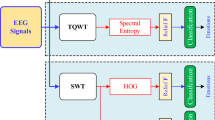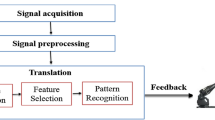Abstract
Using the DEAP dataset, this conference paper aims to investigate the effectiveness of K-Nearest neighbours (KNN) and Multilayer Perceptron (MLP) classifiers in the context of emotion recognition. The primary focus is on decoding valence-arousal emotions, with special attention to how EEG bands are represented in relation to time and channels. The study comprises pre-processing and feature extraction from the multimodal DEAP dataset, which contains EEG signals associated with emotional responses. The Valence-Arousal model is chosen because it may be used to capture the essential elements of affective experiences. KNN and MLP, two distinct classifiers, are used to assess how well they distinguish emotions from EEG signals. The efficacy of these classifiers is evaluated using a range of metrics, such as accuracy, precision, re-call, and F1-score, which offer a thorough grasp of both their benefits and drawbacks. The study also examines the representation of EEG bands across time and across channels in order to find trends and connections in emotional responses. This means taking a close look at the ways in which different frequency bands help distinguish between Valence-Arousal emotions and offer insights into the temporal and spatial dynamics of emotional processing. The EEG data processing process employed the Multi-layer Perceptron (MLP) and k-Nearest neighbours (KNN) algorithms to assess the precision of the Arousal and Valence classifications in different regions of the brain. In the left region, KNN outperformed MLP in terms of arousal (69.11% vs. 60.16%) and valence (69.35% vs. 62.89%). Similarly, KNN scored better than MLP in the parietal region in terms of accuracy for valence (66.67%) and arousal (68.29% vs. 60.16%). In the middle region, KNN outperformed MLP in terms of valence accuracy (72.34% vs. 65.77%) whereas MLP had a lower arousal accuracy (57.72% vs. 68.29%). These results emphasise how crucial it is to take into account technique choice as well as brain regions when evaluating EEG data related to affective states. The findings may have an impact on the creation of more accurate and efficient emotion recognition systems, which may have an impact on applications in affective computing, human-computer interface, and medicine.
Access this chapter
Tax calculation will be finalised at checkout
Purchases are for personal use only
Similar content being viewed by others
References
Kim, D.-W., Im, C.-H.: EEG spectral analysis. In: Im, C.-H. (ed.) Computational EEG Analysis: Methods and Applications, pp. 35–53. Springer Singapore, Singapore (2018). https://doi.org/10.1007/978-981-13-0908-3_3
Wu, T., Fan, Y., Zhong, Y., Cheng, X., Kong, X., Chen, L.: SCNet: a spatial feature fused convolutional network for multi-channel EEG pathology detection. Biomed. Signal Process. Control. 86, 105059 (2023). https://doi.org/10.1016/j.bspc.2023.105059
Koelstra, S., et al.: DEAP: a database for emotion analysis using physiological signals. In: IEEE Transactions on Affective Computing, Special Issue on Naturalistic Affect Resources for System Building and Evaluation (in press)
Du, X., et al.: An efficient LSTM network for emotion recognition from multichannel EEG signals. IEEE Trans. Affective Comput. 13(3), 1528–1540 (2022). https://doi.org/10.1109/TAFFC.2020.3013711
Jha, S.K., Suvvari, S., Kumar, M.: Emotion Recognition from Electroencephalogram (EEG) Signals Using a Multiple Column Convolutional Neural Network Model. SN Comput. Sci. 5(2), 213 (2024)
Atul Chauhan, S.K.J.: Sharing image through Visual Secret Sharing Scheme using Speech Recognition Method. IJAST 28(16), 303–307 (2019)
Song, T., Zheng, W., Song, P., Cui, Z.: EEG emotion recognition using dynamical graph convolutional neural networks. IEEE Trans. Affective Comput. 11(3), 532–541 (2020). https://doi.org/10.1109/TAFFC.2018.2817622
Li, X., et al.: EEG based emotion recognition: a tutorial and review. ACM Comput. Surv. 55(4), 1–57 (2022). https://doi.org/10.1145/3524499
Priyanka, S., Dema, D., Jayanthi, T.: Feature selection and classification of Epilepsy from EEG signal. In: 2017 International Conference on Energy, Communication, Data Analytics and Soft Computing, ICECDS 2017, pp. 2404–2406 (2018). https://doi.org/10.1109/ICECDS.2017.8389880
MohanBabu, G., Anupallavi, S., Ashokkumar, S.R.: An optimized deep learning network model for EEG based seizure classification using synchronization and functional connectivity measures. J. Ambient. Intell. Humaniz. Comput. 12(7), 7139–7151 (2020). https://doi.org/10.1007/s12652-020-02383-3
Najmusseher, Umme Salma, M.: Impact of feature selection techniques for EEG-based seizure classification. In: Lecture Notes in Networks and Systems, vol. 613 LNNS, pp. 197–207 (2023). https://doi.org/10.1007/978-981-19-9379-4_16/COVER
Jha, S.K., Suvvari, S., Kumar, M.: Maximizing emotion recognition accuracy with ensemble techniques on EEG signals. Recent Adv. Comput. Sci. Commun. 17(5), 24–36 (2024). https://doi.org/10.2174/0126662558279390240105064917
Jha, S.K., Suvvari, S., Kumar, M.: EEG-based emotion recognition: an in-depth analysis using DEAP and SEED datasets. In: 2024 11th International Conference on Computing for Sustainable Global Development (INDIACom), New Delhi, India, pp. 1816–1821 (2024). https://doi.org/10.23919/INDIACom61295.2024.10498398
Author information
Authors and Affiliations
Corresponding author
Editor information
Editors and Affiliations
Rights and permissions
Copyright information
© 2025 The Author(s), under exclusive license to Springer Nature Switzerland AG
About this paper
Cite this paper
Jha, S.K., Suvvari, S., Kumar, M. (2025). Exploring the Impact of KNN and MLP Classifiers on Valence-Arousal Emotion Recognition Using EEG: An Analysis of DEAP Dataset and EEG Band Representations. In: Singh, M., et al. Advances in Computing and Data Sciences. ICACDS 2024. Communications in Computer and Information Science, vol 2194. Springer, Cham. https://doi.org/10.1007/978-3-031-70906-7_1
Download citation
DOI: https://doi.org/10.1007/978-3-031-70906-7_1
Published:
Publisher Name: Springer, Cham
Print ISBN: 978-3-031-70905-0
Online ISBN: 978-3-031-70906-7
eBook Packages: Computer ScienceComputer Science (R0)




